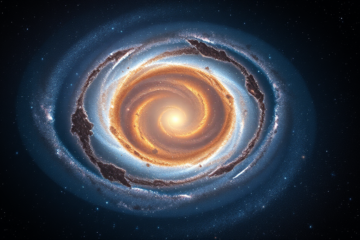Discovery of Planet Formation in HOPS-315
The Formation of Planets is one of the most fascinating mysteries of modern astronomy.
Recently, direct observation of this process was made around the young star HOPS-315, located 1,300 light-years from Earth.
Using the advanced ALMA and James Webb telescopes, scientists have been able to detect grains of rocky material solidifying in a protoplanetary disk.
This article will explore the details of this groundbreaking discovery, the chemical elements involved, and what it reveals about the early stages of planetary formation in relation to our own Solar System.
We will also discuss future prospects for observing young stars.
Direct Observation of Planetary Formation in HOPS-315
Astronomers have for the first time directly observed planet formation around the young star HOPS-315, a stunning achievement made possible by cooperation between telescopes. SOUL It is James Webb.
Located approximately 1,300 light-years from Earth, HOPS-315 is less than 100,000 years old, an impressive age for a star already in the planetary formation stage.
This observation is significant because it shows initial grains of rocky material solidifying within a protoplanetary disk, a fundamental step in the creation of planets.
The discovery highlights elements such as silicon monoxide (SiO) and silicate crystals, which indicate the cooling of gas and the subsequent creation of solids around HOPS-315. This region is now seen as a baby photo of our Solar System, providing unique insights into how planets may have formed in their earliest stages.
The importance of this discovery cannot be underestimated, as it opens the door to extensive investigations into the dynamics and chemical composition during the earliest periods of planetary formation.
Looking ahead, the intention is to expand this type of observation to other young stars, allowing scientists to further deepen their understanding of planetary genesis.
Such studies not only help draw parallels with our own solar system, but also provide insights into the diversity of worlds forming beyond known boundaries.
As one of the scientists involved stated, “This discovery symbolizes a new chapter in astronomy, where we can now watch, in real time, the birth of new worlds.
” For more details on this groundbreaking observation, check out the article in the journal Brazilian Mail.
Detection of the First Rocky Grains in the Protoplanetary Disk
The identification of the first rocky grains in the protoplanetary disk of HOPS-315 represents a step forward. crucial in astronomy.
Using a combination of telescopes ALMA and James Webb, scientists have detected clear signs of solidification in the protoplanetary disk around this young star, located approximately 1,300 light-years from Earth.
The protoplanetary disk is a dense cloud of gas and dust that relevant for planet formation, mimicking the primordial environment of our own Solar System.
The presence of elements such as silicon monoxide and silicate crystals suggests the beginning of the transition of state of matter, from gas to solid.
Telescopes made significant contributions to this discovery:
- SOUL: detailed millimeter mapping of the disc.
- James Webb: ability of infrared spectroscopy to identify chemical compounds.
- Capture of high-resolution images, allowing a detailed view of the processes sublimation and formation of solids.
This observation opens up new possibilities for understanding the early stages of planetary creation and motivates future observations of similar stars to deepen our understanding of the evolution of solar systems.
Chemical Composition and Gas Cooling in HOPS-315
The observation of silicon monoxide (**SiO**) grains and silicate crystals in the protoplanetary disk around the young star HOPS-315 offers fascinating insights into planet formation.
In the initial stage, these compounds are crucial, as sublimation It is cooling of gas play a vital role.
**SiO**, in particular, appears in high concentration, indicating that the cooling necessary for solid formation has already begun.
The planet formation process involves the condensation of unstable gaseous material into solid structures, an essential step captured clearly in this phase.
Furthermore, silicate crystals, which are found in large quantities, corroborate the phase change from gas to solid.
This transition occurs as the temperature of the protoplanetary disk decreases, allowing the accretion of materials and, subsequently, the formation of planetary bodies.
Below, we present a table highlighting the elements detected in HOPS-315 and their implications for planetary formation.
| Element Detected | Evidence of Planetary Formation |
|---|---|
| Silicon monoxide | High abundance |
| Silicate crystals | Formation of solid structures |
The presence of these compounds in HOPS-315 not only reflects a fundamental stage in planetary development but also offers a window into the origins of systems like our own. As we expand our observations to other stars, additional insights into this still poorly understood process may be revealed, shedding further light on the evolution of extrasolar solar systems.
Scientific Impact and Future Perspectives
The direct observation of planet formation in HOPS-315 marks a significant progress in modern astronomy.
Less than 100,000 years old, the young star offers a initial image of what our Solar System could have been in its early days.
By identifying elements such as silicon monoxide and silicate crystals, scientists have concrete evidence of how rocky materials begin to solidify in a protoplanetary disk.
This phenomenon is fundamental, considering that the cooling of interplanetary gas and the formation of solids are crucial steps for the establishment of future planets.
According to a renowned astronomer, “This discovery is like a window into our own planet’s past.
”
Furthermore, the success of HOPS-315 encourages the scientific community to explore other young stars with cutting-edge technologies such as ALMA and the James Webb Telescope.
Observing and comparing different stars will allow us to fill existing gaps in our understanding of planetary formation.
This search promises not only to deepen our knowledge of the evolution of stars, but also of the diversity of planetary systems in our galaxy.
Examining a variety of celestial bodies contributes to a more robust model of planetary origin and, perhaps, helps answer big questions about life in the universe.
In summary, the observation of Planet Formation in HOPS-315 opens new doors to understanding the origin of worlds in our cosmos.
Future observations promise to provide even more insights into how these processes unfold in young stars.



0 Comments